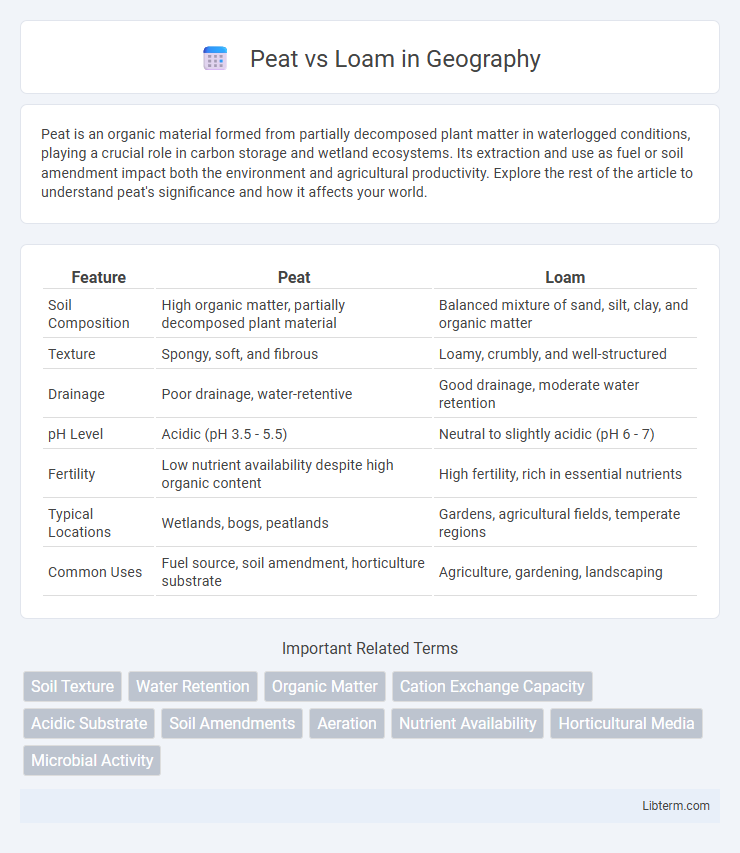Peat is an organic material formed from partially decomposed plant matter in waterlogged conditions, playing a crucial role in carbon storage and wetland ecosystems. Its extraction and use as fuel or soil amendment impact both the environment and agricultural productivity. Explore the rest of the article to understand peat's significance and how it affects your world.
Table of Comparison
| Feature | Peat | Loam |
|---|---|---|
| Soil Composition | High organic matter, partially decomposed plant material | Balanced mixture of sand, silt, clay, and organic matter |
| Texture | Spongy, soft, and fibrous | Loamy, crumbly, and well-structured |
| Drainage | Poor drainage, water-retentive | Good drainage, moderate water retention |
| pH Level | Acidic (pH 3.5 - 5.5) | Neutral to slightly acidic (pH 6 - 7) |
| Fertility | Low nutrient availability despite high organic content | High fertility, rich in essential nutrients |
| Typical Locations | Wetlands, bogs, peatlands | Gardens, agricultural fields, temperate regions |
| Common Uses | Fuel source, soil amendment, horticulture substrate | Agriculture, gardening, landscaping |
Introduction to Peat and Loam
Peat is an organic soil type composed primarily of partially decomposed plant material with high moisture retention and acidic properties, commonly found in wetlands and bogs. Loam consists of a balanced mixture of sand, silt, and clay, offering excellent drainage and nutrient retention, making it an ideal growing medium for a wide variety of plants. Both peat and loam play crucial roles in horticulture, with peat improving soil acidity and moisture, while loam supports root development through its fertile structure.
Defining Peat Soil
Peat soil is characterized by its high organic matter content, formed from partially decomposed plant material in waterlogged environments, which results in excellent water retention but poor drainage. It is acidic and nutrient-poor compared to loam soil, which comprises balanced proportions of sand, silt, and clay, offering superior nutrient availability and drainage. Understanding the distinct physical and chemical properties of peat soil is crucial for optimizing plant growth and soil management practices.
Characteristics of Loam Soil
Loam soil is characterized by a balanced mixture of sand, silt, and clay, offering excellent drainage and nutrient retention crucial for plant growth. Its crumbly texture promotes aeration and root penetration, making it ideal for gardening and agriculture. Compared to peat, loam soils typically have a near-neutral pH and higher mineral content, supporting a wider variety of crops.
Key Differences Between Peat and Loam
Peat soil is rich in organic matter and has high water retention but poor drainage, making it acidic and low in nutrients compared to loam. Loam soil is a balanced mixture of sand, silt, and clay that offers excellent drainage, aeration, and fertility, ideal for most plants. The key differences lie in texture, nutrient content, pH level, and water retention capacity, with loam providing a more neutral and nutrient-rich growing medium than peat.
Nutrient Content Comparison
Peat soil contains high organic matter but is generally low in essential nutrients such as nitrogen, phosphorus, and potassium, requiring supplementation for optimal plant growth. Loam soil features a balanced mixture of sand, silt, and clay, providing a rich nutrient profile with naturally occurring macronutrients and micronutrients crucial for plant development. The nutrient retention capacity of loam is superior to peat, promoting sustained nutrient availability and healthier root systems.
Water Retention and Drainage
Peat soil retains a high amount of water due to its organic structure, making it ideal for moisture-loving plants but potentially causing poor drainage and root rot in others. Loam soil balances water retention and drainage effectively, consisting of sand, silt, and clay that provide adequate moisture while preventing waterlogging. Gardeners often prefer loam for its versatility, as it promotes healthy root growth by maintaining optimal oxygen levels and moisture content.
Suitability for Gardening and Crops
Loam soil, composed of balanced sand, silt, and clay, offers excellent drainage, aeration, and nutrient retention ideal for most gardening and crop cultivation needs. Peat soil, rich in organic matter and moisture, is highly suitable for acid-loving plants and wetland crops but may require modification with lime and fertilizers to support a wider variety of plants. Gardeners often choose loam for versatile crop growth, while peat is preferred for enhancing soil structure in specific horticultural applications.
Environmental Impact and Sustainability
Peat extraction significantly contributes to carbon emissions due to the release of stored carbon dioxide from disturbed peatlands, making its use less sustainable. Loam, composed of balanced sand, silt, and clay, supports diverse soil ecosystems and promotes sustainable agriculture through improved water retention and nutrient availability. Choosing loam over peat reduces environmental degradation and aids in conserving vital natural carbon sinks, fostering long-term ecological stability.
Cost and Availability
Peat soil tends to be more expensive due to limited availability and the cost of sustainable harvesting practices, whereas loam is generally more affordable and widely accessible in most regions. Peat's high cost is influenced by environmental regulations and its slower replenishment rate compared to loam, which is a naturally abundant, balanced mixture of sand, silt, and clay. Gardeners and landscapers often prefer loam when budgeting, as it provides essential nutrients and good drainage at a lower price point.
Choosing the Right Soil for Your Needs
Peat soil, rich in organic matter and moisture retention, excels for acid-loving plants and wetland gardens, while loam offers a balanced texture with ideal drainage and nutrient content suitable for most garden plants and vegetables. Selecting the right soil depends on plant type and environmental conditions; loam supports healthy root development and soil aeration, whereas peat is preferred for moisture retention and acidic soil requirements. Understanding soil pH, nutrient levels, and water retention capabilities ensures optimal plant growth and soil management.
Peat Infographic

 libterm.com
libterm.com